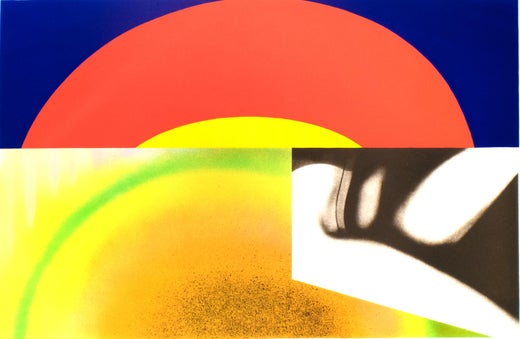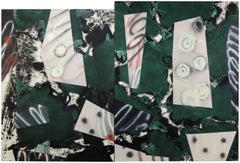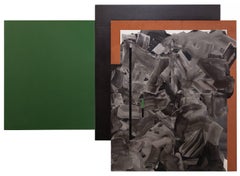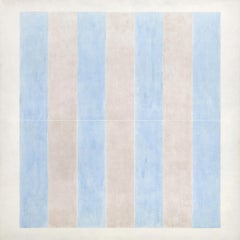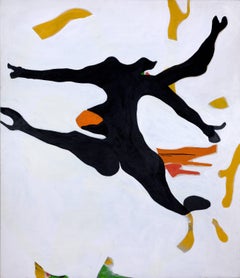James RosenquistTelevision or the Cat's Cradle Supports Electronic Picture1988 - 99
1988 - 99
About the Item
- Creator:James Rosenquist (1933, American)
- Creation Year:1988 - 99
- Dimensions:Height: 66 in (167.64 cm)Width: 240 in (609.6 cm)
- Medium:
- Movement & Style:
- Period:
- Condition:
- Gallery Location:Palm Desert, CA
- Reference Number:Seller: 156771stDibs: LU938232012
James Rosenquist
Although he insisted that he and his fellow Pop artists developed their art-making styles independently, American painter James Rosenquist belonged at the table with Andy Warhol and Roy Lichtenstein.
Known for his distinctive use of visual montage, Rosenquist produced large, vibrantly colored tableaux marked by fragmentation and overlap. He often employed familiar motifs and objects drawn from popular contemporary culture — hot dogs, lipstick tubes, American flags — which he manipulated to form disorienting compositions whose constituent elements are nearly unrecognizable.
Born in North Dakota to Swedish parents, Rosenquist was encouraged to pursue painting by his mother, who was also an artist. He studied painting for two years at the University of Minnesota, but dropped out at the age of 21 to attend the Art Students League in New York on a scholarship. A job as a billboard painter in the late 1950s set him up to pursue his signature style, which borrowed its bold graphics and remixed kitschy aesthetic from the visual vocabulary of advertising. Works like Flamingo Capsule (1983) embody his trademark visual dissonance, drawing cigarette-ad motifs into conversation with stripes from the American flag and aluminum foil wrappers.
In addition to enormous paintings, Rosenquist created drawings, prints and collages. The 2011 lithograph The Memory Continues but the Clock Disappears is a montage of melting clocks and confetti, all submerged in a pool of water. While wryly hinting at the inevitability of decay and deterioration — suggesting that life is a ticking clock — the composition also alludes to Salvador Dalí's signature motif, the defining symbol of Surrealism. Such compositions demonstrate how Rosenquist masterfully combined seemingly incongruous elements into a harmonious and poetic whole.
Find James Rosenquist art today on 1stDibs.
You May Also Like
21st Century and Contemporary Post-War Abstract Paintings
Canvas, Acrylic, Stretcher Bars
Early 2000s Post-War Abstract Paintings
Canvas, Acrylic, Stretcher Bars
1980s Post-War Abstract Paintings
Canvas, Acrylic
1980s Post-War Abstract Paintings
Canvas, Acrylic
1980s Post-War Abstract Paintings
Canvas, Acrylic
1960s Post-War Abstract Paintings
Canvas, Acrylic
1960s Post-War Abstract Paintings
Canvas, Acrylic
1970s Post-War Abstract Paintings
Canvas, Mixed Media, Acrylic
1970s Post-War Abstract Paintings
Canvas, Acrylic, Graphite
Late 20th Century Post-War Abstract Paintings
Acrylic, Satin Paper, Pen
More From This Seller
View AllLate 20th Century Post-War Abstract Paintings
Canvas, Acrylic
Early 2000s Post-War Abstract Paintings
Acrylic, Canvas
20th Century Post-War Abstract Paintings
Gesso, Canvas, Acrylic, Pencil
1970s Post-War Abstract Paintings
Canvas, Acrylic
1960s Post-War Abstract Paintings
Canvas, Wood, Acrylic
Mid-20th Century Post-War Abstract Paintings
Canvas, Mixed Media, Acrylic
Recently Viewed
View AllRead More
Penelope Gottlieb’s Comic-Style Painting Is a Requiem for a Vanished Flower
This piece may look like Pop art fun, but embedded within is a message of a planet on the brink.
10 Reasons Art Collectors Are Obsessed with Andy Warhol
More than three decades after his death, the prolific Pop artist and cultural icon's body of work continues to captivate. Here's a primer of some of his most notable motifs and mediums.
